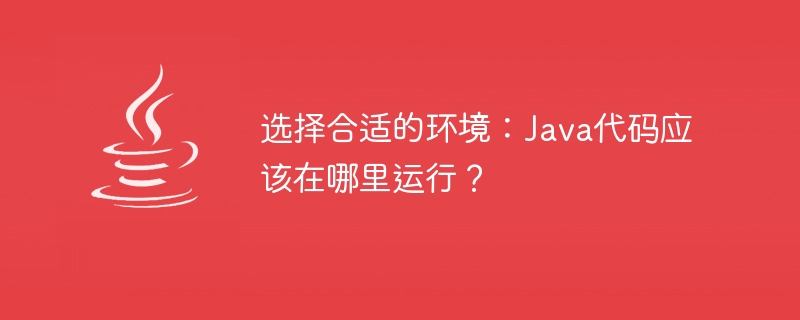Home >Java >javaTutorial >Determining the optimal deployment environment: Where is the best place for a Java application to run?
Determining the optimal deployment environment: Where is the best place for a Java application to run?
- 王林Original
- 2024-02-18 16:03:061202browse

Choose the right environment: Where should your Java code run?
Introduction:
Java is an object-oriented programming language that is widely used in the development of various applications and systems. It is very important for Java developers to choose the right environment to run their code. In this article, we will discuss several common Java code running environments and provide some specific code examples to help readers better understand and choose the environment that suits them.
- Command line environment:
The command line environment is the most basic and simple Java code running environment. It does not require any graphical interface or other complex settings, only a command line terminal. You can run Java code in the command line environment by following the following steps:
Step 1: Open the command line terminal.
Step 2: Use a text editor to write Java code and save it as a .java file.
Step 3: Use the javac command to compile the .java file into a .class file.
Step 4: Use the java command to execute the compiled .class file.
The following is an example of Java code running in a command line environment:
public class HelloWorld {
public static void main(String[] args) {
System.out.println("Hello, World!");
}
}- Integrated Development Environment (IDE):
Integrated Development Environment (IDE) is a function Powerful development tools provide developers with a series of functions, such as code editing, debugging, building, auto-completion, etc. If you are an experienced Java developer, you will usually use an IDE for development.
Currently the more popular Java IDEs include Eclipse, IntelliJ IDEA and NetBeans. The following are the steps to run the above sample code using Eclipse IDE:
Step 1: Open Eclipse IDE.
Step 2: Create a new Java project.
Step 3: Create a new Java class in the project and paste the code into the class.
Step 4: Click the run button or use shortcut keys to execute the code.
- Java Virtual Machine (JVM):
Java Virtual Machine (JVM) is the running environment for Java programs. It is responsible for interpreting and executing Java bytecode. Java applications must run on a JVM, which means you can run Java code on almost any operating system.
The following is an example of using the JVM to run Java code:
public class HelloWorld {
public static void main(String[] args) {
System.out.println("Hello, World!");
}
}In the command line terminal, use the javac command to compile the above code, and use the java command to run the compiled. class file.
Summary:
Choosing the right environment to run Java code is very important for developers. The command line environment is the simplest running environment, suitable for beginners or simple code testing. Integrated development environment (IDE) provides richer functions and tools, suitable for experienced developers to develop complex projects. The Java Virtual Machine (JVM) is the necessary environment to run Java code and can run Java applications on almost any operating system.
I hope this article has provided some help for readers to choose a Java code running environment that suits them. No matter which environment you choose, as long as you use them wisely, you can develop and run Java programs efficiently.
The above is the detailed content of Determining the optimal deployment environment: Where is the best place for a Java application to run?. For more information, please follow other related articles on the PHP Chinese website!

